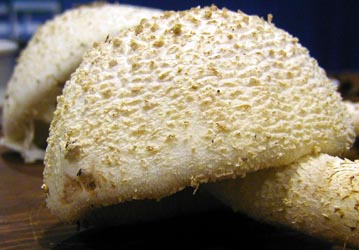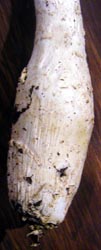|
[ Amanita rhopalopus f. turbinata ]
[ Section Lepidella page. ]
[ Amanita Studies home. ]
[ Keys & Checklist/Picturebooks ] Amanita rhopalopus Bas
Technical description (t.b.d.) BRIEF DESCRIPTION: The following is based on the description of Bas (1969). The cap of A. rhopalopus is (30-) 50 - 180 mm wide, white, with the center sometimes subumbonate, although usually somewhat depressed with age. This species has a nonsulcate, appendiculate, initially inflected margin that may extend several mm beyond the ends of the gills. The cap is densely covered with whitish, adnate to subdetersile, subverrucose, floccose-felted or subfelted patches, irregularly shaped, subfloccose warts or, especially at the center, subfloccose, conical warts. The gills are crowded to rather crowded, free to narrowly adnate, moderately broad to rather narrow, thin, and white to pale cream. The shortest gills are truncate; the remainder of the short gills are attenuate. The stem is about (50-) 120 - 200 x (4-) 10 - 25 mm, subcylindrical or narrowing upward, solid, white, mostly with some inconspicuous to rather distinct, subfloccose-felted warts, scattered or in a few circles at the base of the stem. The apex of the stem may be floccose from remnants of the annulus that is usual torn early in development and uncommonly leaves an appressed floccose ring near the stem apex. The basal bulb of the stem is often deeply rooting, mostly enlarged, cylindric to subclavate to fusiform. A small bulb collected whole measured 70 x 31 mm; however, the bulbs can get much larger than this. There are false rootlets at the base of the bulb. The odor of this species is strong and pungent of decaying protein. The spores measure (7.3-) 8.0 - 10.9 (-12.5) x (4.8-) 5.4 - 6.8 (-8.1) Ám and are amyloid and ellipsoid to elongate. Small clamps are present at bases of basidia. Amanita rhopalopus was originally described from the eastern U.S. Its range is presently known to extend from New York to Tennessee and North Carolina. It is found in oak, pine-oak, and beech-oak forests. It appears to be an upland species in the southern part of its range. The present species can be confused with an as yet undescribed taxon that has a largely overlapping distribution. The undescribed entity is also white with flocculent volva; however, its stem base is narrower and radicates so deeply that I've never known a specimen to be collected in its entirety. The annulus of the undescribed species is distinctly less membranous from the outset; and its spores are markedly more narrow on average than in A. rhopalopus. In my experience, the undescribed species is more common than A. rhopalopus in some regions and is often misdetermined as A. rhopalopus.
For some reason, A. rhopalopus is sometimes confused with A. ravenelii (Berk. & Curt.) Sacc. of Bas' stirps Ravenelii. The nature of the two volvas is very distinct. In the field, a hand lens will quickly reveal the radially oriented nature of grooves and fibers on the warts of A. ravenelii that is illustrated on the page for that species. The warts of A. rhopalopus are more nearly formless. Bas based his stirps Rhopalopus on the present species. This stirps also was defined as including A. conicobulbosa Cleland (from Australia) and A. smithiana Bas (from western North America). -- R. E. Tulloss Line illustration: Dr. C. Bas (1969) (reproduced courtesy of Persoonia, Leiden, the Netherlands) Amanita rhopalopus f. turbinata Bas Bas (1969) states this form differs from typical A. rhopalopus only by a "huge" top-shaped bulb. My own observations and those of some correspondents indicate that bulb shape is very variable in A. rhopalopus and that f. turbinata seems not to have taxonomic significance on the grounds of bulb-shape alone. While Bas' spore measurements from three collections for f. turbinata show spores slightly smaller than those of the type form, my measurements from three different collections shows spores slightly larger than those of the type form. Combining these two sets of data on f. turbinata, the available spore data for f. turbinata is very similar to available data on the spores of the type form. As can be seen at the top of the page, RET has proposed to place f. turbinata in synonymy with the type form. The current form was originally described from North Carolina, USA. It is also known from West Virginia and Arkansas, USA. With solitary oak or in mixed-woods.
[ top ] Last changed 19 March 2009. |



